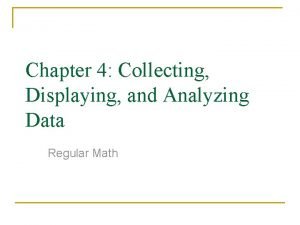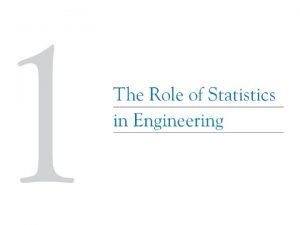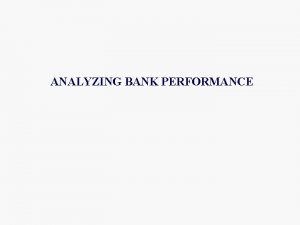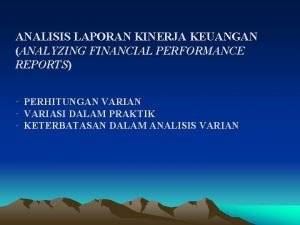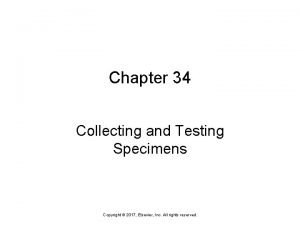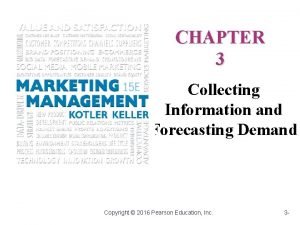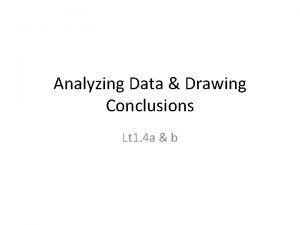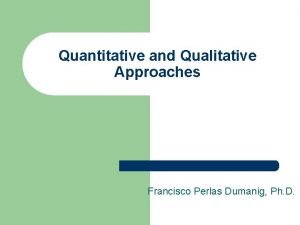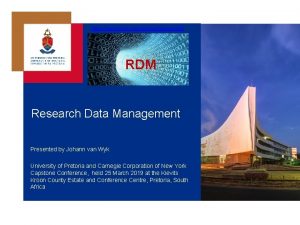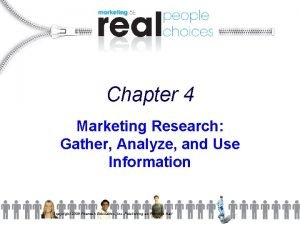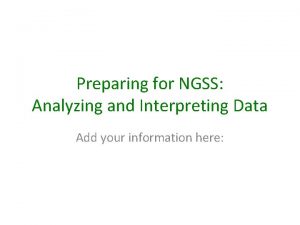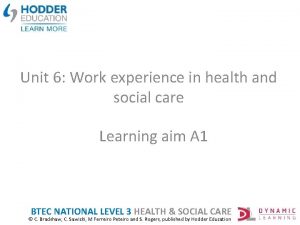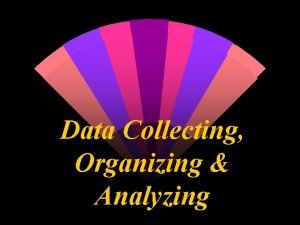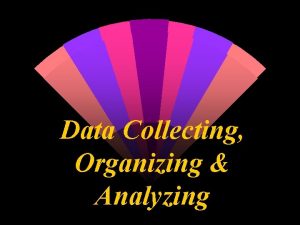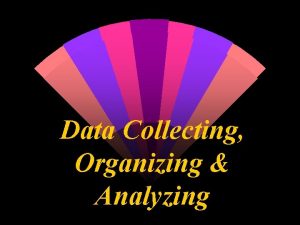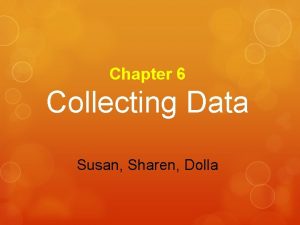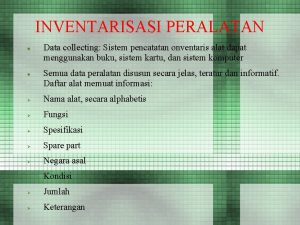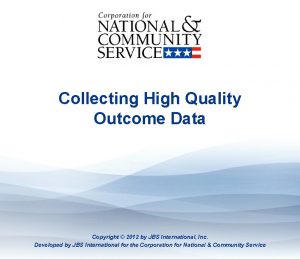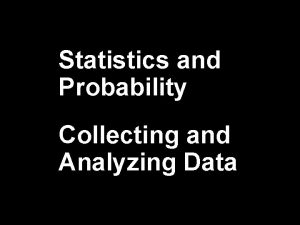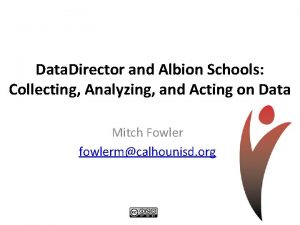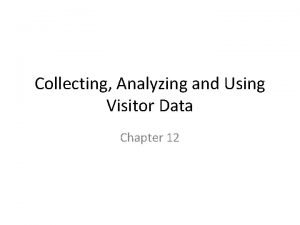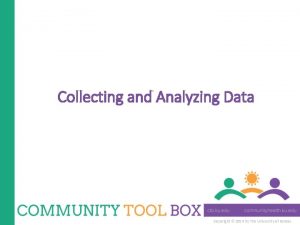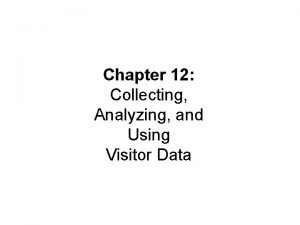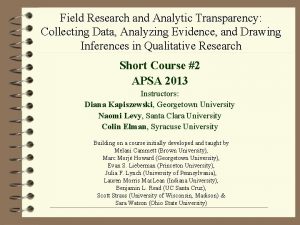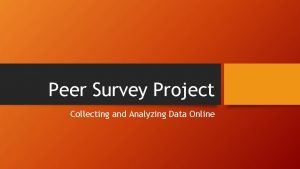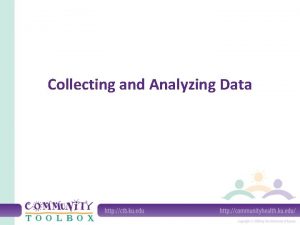Collecting and analyzing social performance data Experience of






















- Slides: 22

Collecting and analyzing social performance data: Experience of SANASA Development Bank Hosted by Amelia GREENBERG (SPTF) Guest speakers: Nilupama Madurawala (SANASA Development Bank) Veena Yamini A (Micro. Save) 06 March 2014

Agenda • Review dimension 1 of the Universal Standards • Overview of Micro. Save ‘Social Performance Management Implementation Project’ in Asia • SANASA experience • Q&A

Dimension 1 of the Universal Standards • Dimension Title: Define and Measure Social Goals • Rationale: An institution must have a clear strategy for achieving its social goals and must measure its progress toward achieving these goals. • Two standards: ▫ 1 a- The institution has a strategy to achieve its social goals. ▫ 1 b -The institution collects, reports, and ensures the accuracy of client-level data related to the institution’s social goals.

1 a- The institution has a strategy to achieve its social goals.

Standard 1 a- The institution has a strategy to achieve its social goals. Essential Practices • 1 a 1 The institution's strategy includes a formal mission statement, which includes increasing access to financial services for vulnerable or excluded target groups and creating benefits for these clients. • 1 a 2 The institution's strategy defines the specific characteristics of its target clients. • 1 a 3 The institution's strategy defines its social goals. • 1 a 4 The institution's strategy defines measurable social targets for client-level outputs and outcomes. • 1 a 5 The institution's strategy defines social indicators to measure progress towards social goals. • 1 a 6 The institution's strategy articulates how its products, services, delivery models and channels will achieve its social goals.

1 b – The institution collects, reports, and ensures the accuracy of clientlevel data that are specific to the institution’s social goals.

Standard 1 b- The institution collects, reports, and ensures the accuracy of client-level data that are specific to the institution’s social goals. Essential Practices • 1 b. 1 The institution collects data for each of its social goals and the MIX social performance data. • 1 b. 2 The institution has protocols for the collection, quality control, analysis, and reporting of social performance data. • 1 b. 3 The institution ensures the quality of the data collected by validating its data and training its employees on data collection and entry. • 1 b. 4 The institution's management information system disaggregates data by gender and other client characteristics. • 1 b. 5 If the institution states poverty reduction as one of its social goals, it monitors the poverty levels of its clients using a poverty assessment tool. • 1 b. 6 The institution discloses social performance information, including the MIX Social Performance data.

Micro. Save ‘Social Performance Management Implementation Project’ (1/2) • Implemented from 2010 -12 in India, Bangladesh and Sri Lanka • Eight organizations participated (5 in Phase I and 3 in Phase II) • Range of organization types: from NGO-MFI to for-profit MFIs to development cooperative bank • Purpose: to drive the adoption of social performance reporting standards in the microfinance sector & integrating these reporting metrics in the decision making and management of microfinance institutions (MFIs)

Micro. Save ‘Social Performance Management Implementation Project’ (2/2) • Project activities: § Develop social indicators § Develop social performance reporting formats § Support the SANASA MIS and vendor to develop an online SPM reporting module § Conduct Training of the Trainers (To. T) on PPI for master trainers § Develop a sample survey research plan • Result to share: Separate SPM module developed by SANASA

Integrating Social Indicators into Information Systems: Key Considerations Clarify Social Goals Data Collection § Which social indicators do you want to track and report? § What (aspirational) targets do you want to assign to indicators ? § Which data collection approach will you use? (Census Vs. Sample) § How will data collection be done? automated or hard copy? § Which tool (s) will be used to collect data? E. g. loan application forms, account opening forms, survey questionnaires? § Frequency and timing of data acquisition: How often are the data collected? When will this data be collected? § Individual responsible: Who will be responsible (what department, which staff position, external parties) for the data collection? § Location of data storage: Where will the raw data be stored (which office for physical documents, system)?

Integrating Social Indicators into Information Systems: Key Considerations Data Validation § Quality of data: Who will validate data collected? § Who will validate the data entered into the system? § Who will be responsible for training the staff on data collection, entry, validation, collation, analysis, reporting Data Collation &Analysis § Data entry/collation method: Which system will be used to collate and analyse data? MIS, MS Office tools (Access or Excel), research analysis tools § Individual responsible: Specify who is responsible (which department, what staff position) for the data collation and analysis? § Frequency and timing of data collation: When will this data be collated analysed? How often are the data collated analysed? Data Reporting § What tool will be used for reporting (MIS SPM report, or excel reports)? § Who will be responsible for reporting? § How often are the data reported? § Where should the report go to (Board, internal / external decision makers? funders)?

SANASA remarks • Why did you participate in this program? What benefit were you seeking? • How did you select your social indicators? • How did you integrate your social indicators into the MIS? • Provide examples of some of the reports generated using the SPM module • How much does this cost? • Challenges? • Lessons learned? • Benefits already achieved?

Question and Answer with Participants

Where to find resources • The Standards Manual: http: //sptf. info/onlinetrainings/universal-standards-implementation • SPM Resource Library for the Universal Standards: http: //sptf. info/spmstandards/standardsimplementation-resources • This presentation and audio recording : http: //sptf. info/online-trainings/other-trainings • Technical guide – coming soon!

Save the date ! • Second webinar in this series – SPM Project in Africa (OI and Micro. Save) - TBD We will send an invitation with the Web. Ex link to a few weeks before the session

Process adopted for developing Social Indicators Vision, Mission Values Best Practices How are we offering services? Client Outreach What SPM outcomes we want to see? Energy and Environme nt CSR and Corporate Governance HR and Ethics

• % of customer complaints resolved SPM Outcomes • % of rural clients to total clients • % of clients below poverty level • Average savings per client • Average loan size per client • % of loans below XXX Dollars How are services offered? Client Outreach Sample Social Indicators • Client Retention ratio • Jobs created by enterprises which are funded by the organisation

• % of loan applications rejected after environment check • Expense on electricity and paper HR and Ethics • SP reports presented per year to the Board • Client base covered under special programmes of the organisation Environment and Energy CSR and Corporate Governance Sample Social Indicators • % of new employee hires by ethnicity, gender, and region • Staff Attrition Rate • Average days of training per year per employee by employee category • % of employees receiving regular performance reviews • No. of instances of complaints made by employees (either anonymously or otherwise) on suspected violations of financial, accounting, ethical or other policies • % of grievances received from staff

Sample Data Entry Module

Sample Data Entry Module

Sample Report

Sample Report
 Collecting and displaying data
Collecting and displaying data Direct and indirect experience
Direct and indirect experience Collecting highly parallel data for paraphrase evaluation
Collecting highly parallel data for paraphrase evaluation Samples of collecting engineering data
Samples of collecting engineering data Imprinting meaning psychology
Imprinting meaning psychology Early experience vs later experience
Early experience vs later experience Analyzing bank performance
Analyzing bank performance Analyzing financial performance reports
Analyzing financial performance reports Chapter 34 collecting and testing specimens
Chapter 34 collecting and testing specimens Collecting information and forecasting demand
Collecting information and forecasting demand Marketing research and forecasting demand
Marketing research and forecasting demand Making conclusions from analyzed data
Making conclusions from analyzed data Analyzing and visualizing data with microsoft power bi
Analyzing and visualizing data with microsoft power bi Interpreting quantitative data
Interpreting quantitative data Analyzing and interpreting data in research
Analyzing and interpreting data in research Analyzing and interpreting data in research
Analyzing and interpreting data in research Analyzing and interpreting data in research
Analyzing and interpreting data in research Analyzing and interpreting data in research
Analyzing and interpreting data in research Analyzing and interpreting data in research
Analyzing and interpreting data in research Analyzing and interpreting data
Analyzing and interpreting data Unit 6: work experience in health and social care level 3
Unit 6: work experience in health and social care level 3 Social thinking social influence social relations
Social thinking social influence social relations Social thinking social influence social relations
Social thinking social influence social relations
